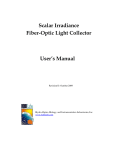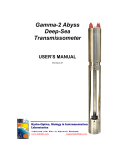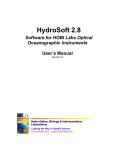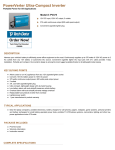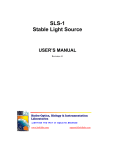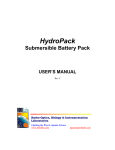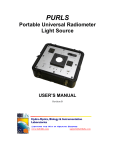Download Fiber-Optic Radiance Collector User`s Manual
Transcript
Fiber-Optic Radiance Collector User’s Manual Revision D Hydro-Optics, Biology, and Instrumentation Laboratories, Inc. www.hobilabs.com Revisions: D—May 1, 2008: Correct o-ring label on drawing C—June 16, 2004: Change o-ring from 5-102 to 3mm x 1mm B—June 16, 2004: Add discussion of cable waterproofing. A—June 13, 2003: First release 2 DESCRIPTION The HOBI Labs fiber-optic radiance collector attaches to an SMA-terminated fiber optic cable to provide a submersible optical receiver with a controlled field of view. When properly assembled, the collector protects the sensitive end of the fiber optic from water. Note that the fiber optic cable itself, supplied by the user, must also be constructed so as to prevent water from entering its own outer jacket. See below for an explanation of this. For the most robust water seals, such as those used in the underwater cables built into HOBI Labs instruments, the collector includes mounting holes and an oring gland for a face seal. These can be used to incorporate it into a larger structure to seal and reinforce the entire fiber optic cable. However those features are unnecessary for many “stand-alone” applications of the collector. SUPPLIED PARTS • • • Collector 2-012 o-ring and spare (needed only if mounting to a special fixture) 3mm x 1mm o-ring and spares USING THE COLLECTOR Before connecting an SMA to the light collector, you must place an o-ring (3 mm internal diameter, 1 mm thick) around the SMA ferrule as shown in the photograph below. This prevents water from entering the collector body, as well as setting the proper insertion depth for the ferrule. IMPORTANT: DO NOT ASSEMBLE THE COLLECTOR WITHOUT THIS O-RING. DOING SO CAN DAMAGE THE COLLECTOR. For best results, tighten the connection by holding 3 the end of the cable stationary and gently rotating the collector. This help to work the o-ring into the correct position without pinching it. The connector should be hand-tightened (rather than using a wrench) to avoid stripping the plastic threads. Inserting SMA connector with 3mm ID, 1mm thick o-ring in place Note that when you remove the SMA, the o-ring will generally remain on the ferrule, and it is easy to overlook the fact that it is there! If the collector is to be mounted onto a sealing surface, first place a lubricated Parker size 2-012 O-ring in the larger groove around the SMA thread, pass the end of the fiber optic patch cord through the sealing surface, and then attach the cord to the collector. Use #4 screws (not supplied) to attach the collector to the sealing surface. PRECAUTIONS AND MAINTENANCE • Always place a 3mm x 1mm o-ring on the SMA ferrule before inserting it. • Keep the inside of the collector clean and dry. • Cover the SMA fitting with tape or a vinyl cap whenever the fiber optic cable is detached. • Do not use a wrench to tighten the connector so much that it could damage the plastic threads. • Do not use acetone to clean any part of the collector. • Upon removing the collector from salt water, before removing fiberoptic cables, rinse thoroughly with fresh water. 4 FIBER OPTIC CABLE CONTRUCTION & WATERPROOFING Most off-the-shelf cables are constructed with a waterproof outer jacket, but this alone does not guarantee the assembly is watertight. The SMA connector on the end of the cable must also be properly sealed at the time of manufacture. Most highquality cables are sealed in this way. Further, water entry into a cable will not necessarily cause problems. Nevertheless it is best avoided, and users should be aware of the following considerations. The most likely entry point for water is where the cable’s outer jacket enters the fiber optic connector. This is normally covered by a strain-relief “boot” as shown below. This boot may or may not form a seal by itself. SMA termination with boot SMA termination with boot removed The arrow in the lower picture marks the point where the jacket enters the connector. At some point inside the connector the jacket ends, at which point it must be sealed. In high-quality commercial cables the connector is typically filled with epoxy, encapsulating the jacket and providing an adequate seal. However since the seal is internal the only way to be sure is to consult the manufacturer. If in doubt, you can provide extra protection by sealing the ends of the boot, or even encapsulating it entirely, with a waterproof adhesive such as the silicone caulking that is used for sealing fish tanks. 5





